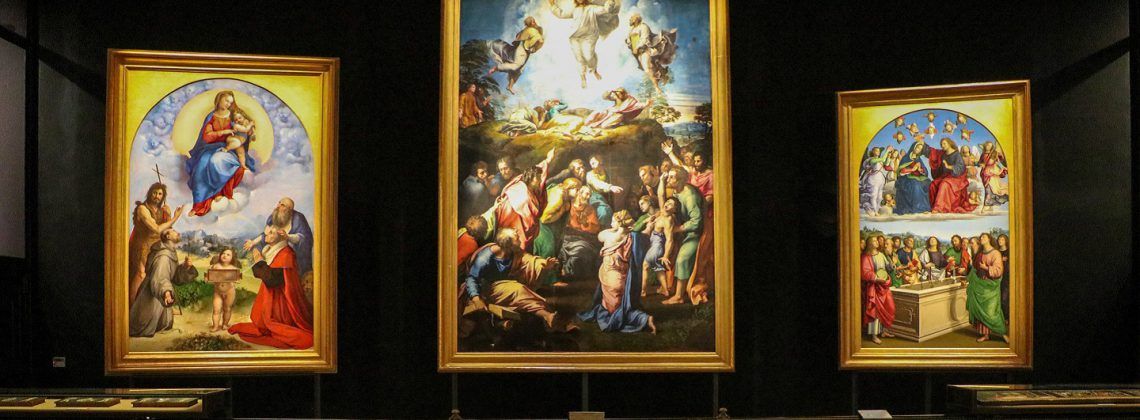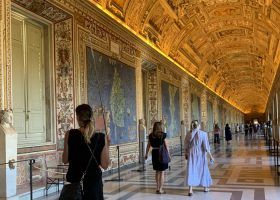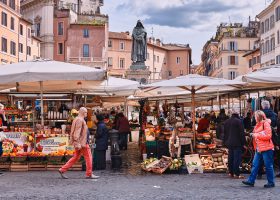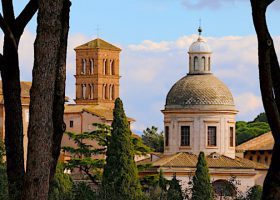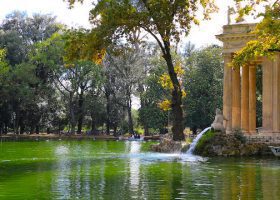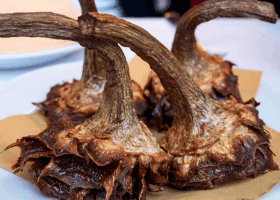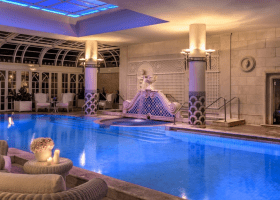As the main patrons of the arts for centuries, the papal art collections are impressive and the Vatican Pinacoteca is no exception. Housing artwork by Raphael, Da Vinci, and Caravaggio, among others, art lovers won’t want to miss it. To make things easier for you, here’s our list of must-see art in the Vatican Pinacoteca.
Pro Tip: Planning your visit to the Vatican? Bookmark this article in your browser so you can easily find it when you’re in the Museums. Also, see our dedicated guide to Vatican City for more planning resources, our top Vatican tours for a memorable trip, and how to visit the Vatican.
What To See at the Vatican Pinacoteca
The word pinacoteca means a painting gallery in Italian and the Vatican’s Pinacoteca gallery doesn’t disappoint. Since the popes in the Vatican have historically been the main patrons of the arts for centuries, that makes sense.
The idea behind building the Pinacoteca originated in the early 19th century after the defeat of Napoleon. He took many paintings to Paris, which were brought back to the Vatican.
This private collection has continued to grow with various popes and donations. Currently, it houses 460 paintings by some of the most celebrated artists in the world. When you visit the Vatican, don’t miss these top paintings in the Pinacoteca. For more, check out our ultra-comprehensive list of what to see at the Vatican written by a licensed Vatican guide!
Not ready to book a tour? See if a Vatican tour is worth it.
10. Transfiguration (Raphael)
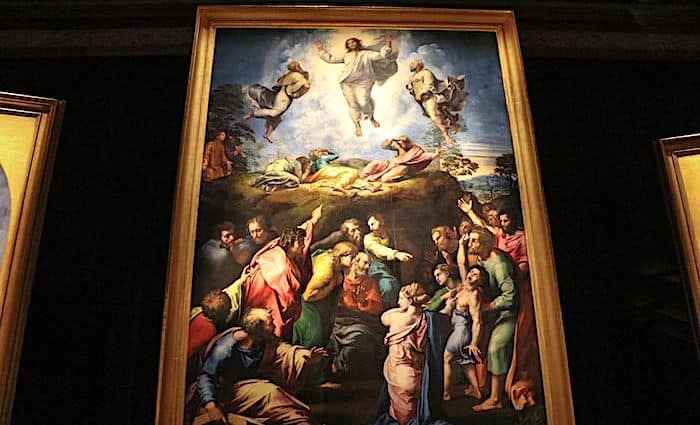
The man who would become Clement VII commissioned this masterpiece for a church in France. In the end, the pope decided to keep it for himself. He eventually donated it to San Pietro in Montorio where it was the altarpiece for two centuries.
Like many pieces, Napoleon took it to France in 1797. After his defeat in 1817, they returned the painting to the Vatican during the treaty of Tolentino. From then on, it has been a defining piece of High Renaissance painting for its dominant colors and ideal beauty.
Use of Vivid Colors
The painting depicts two stories from the Gospel according to Matthew. They are the Transfiguration and the meeting of the apostles with the obsessed youth who would be cured when Jesus returns from Mount Tabor. Mastery is evident in the painting in numerous ways, so let’s start with the color. Raphael was famous for his use of vivid colors. Especially now, after the painting has been cleaned, we can see the colors the way Raphael and his contemporaries would have seen them.
Remember that this was made specifically to be an altarpiece, so it would be up above our heads. Our eyes are naturally drawn to brighter colors, and Raphael played on this by gradually making the colors brighter the further up you look. In doing so, Raphael guides you on how to look at the scene. Start below first and then work your way up to the top of the painting, culminating in Christ himself.
This was Raphael’s last painting. Georgio Vasari, Raphael’s contemporary and biographer, called this painting “the most famous, most beautiful, and most divine.” It was supposedly laid over his tomb during his funeral. Unfortunately, Raphael died at the young age of 37, supposedly from syphilis. He was buried, and remains to this day, in the Pantheon in Rome.
9. The Annunciation (Raphael)
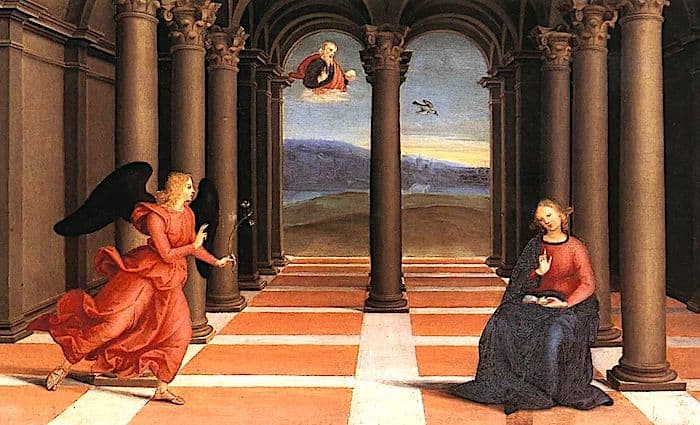
Painted between the years 1502-1504, this is one of Raphael’s earliest works. The Oddi family commissioned it for their family chapel in Perugia.
The angel Gabriel approaches the Virgin Mary to let her know of the imminent coming of Jesus Christ (Annunciation). Mary sits by herself reading a book and seems to be expecting this moment. With ideal beauty reflected in her face, we see this even in the way she holds up her one hand welcoming the Angel.
In the background, you can see two arches that open up to a clear sky. One of Raphael’s trademarks was to add deep perspective in his paintings, which he does here with a light blue colored sky to show the most distant point.
You’ll also notice the 3D effect he creates with the columns and the dove in the distance. This painting resembles a very similar work by his teacher Perugino. Raphael would have studied under the Early-Renaissance master and, eventually, he achieved such mastery that many said they couldn’t tell the difference between master and student.
Popular Rome Tours
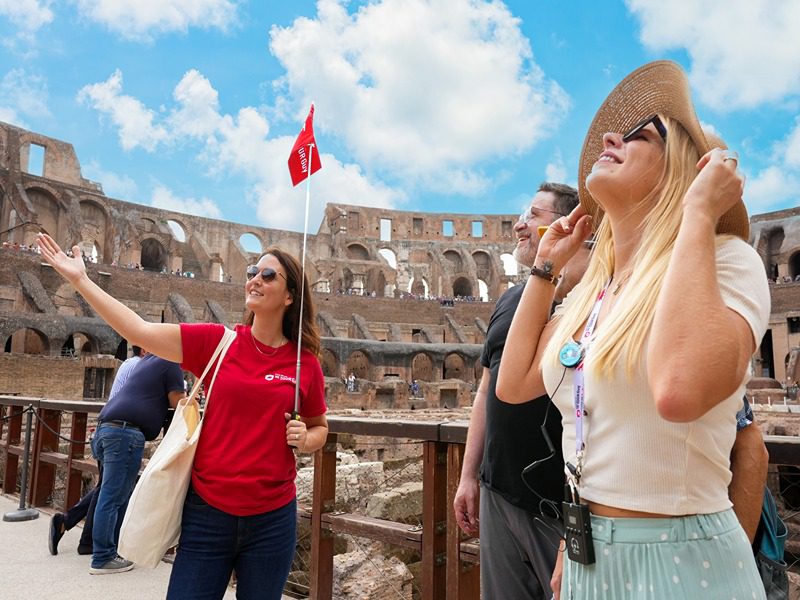
Best-Selling Tour
Rome in a Day Tour with Colosseum and Vatican Museums
Seeing the best of Rome in a single day might seem like a big undertaking, but our expertly designed tour makes it effortless with skip-the-line tickets, included transportation, and engaging guides to lead the way. In just 7 hours, you’ll visit renowned sites like the Sistine Chapel, Colosseum, Trevi Fountain, and Pantheon. With fascinating stories at every stop, you can skip the stress and immerse yourself in the vibrant heritage and culture of Rome all in one remarkable day.
See Prices
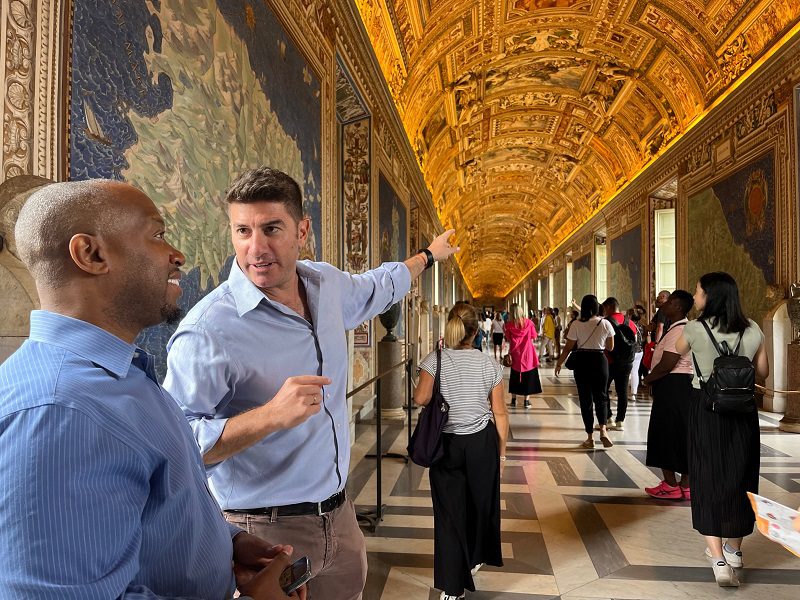
Best Price!
Privileged Entrance Vatican Tour with Sistine Chapel
Without the right access, visiting the Vatican means fighting crowds, long waits, and missing the most significant rooms and works of art. Our privileged entrance tour offers more than just entry—it’s an immersive experience led by a storytelling guide who brings the Vatican to life. Skip the line and explore the Vatican Museums, including the Raphael Rooms and the Sistine Chapel, with engaging insights that make each moment memorable and meaningful.
See Prices
Not ready to book a tour? Find out if Rome tours are worth it.
8. The Crowning of the Virgin (Raphael)
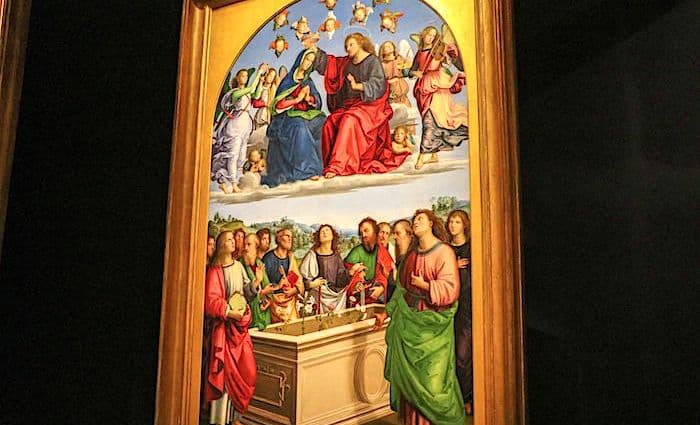
This painting was also part of the altarpiece for the Oddi family chapel in Perugia. This is one of my personal favorites because of the simple and elegant beauty of the individual figures depicted.
The painting is broken down into two scenes. The bottom half shows the grave where the Virgin Mary was laid to rest with the apostles around her. St. Thomas is holding the girdle, which was given as a gift from the virgin herself. Where she would have been in the tomb, there are flowers as she had since ascended to heaven. The apostles are all looking in amazement as they see her image above with Jesus.
The upper portion of the painting depicts the Virgin Mary and Jesus, who is crowning her as the blessed mother. There are angels surrounding them and some are even playing musical instruments. The play on color is similar to the Transfiguration, where the darker colors are below. As your eyes naturally move upwards, the color scheme becomes lighter. The faces show the ideal beauty of man, expressed even more so in the angelic face of the Virgin Mary.
7. St. Jerome (Da Vinci)
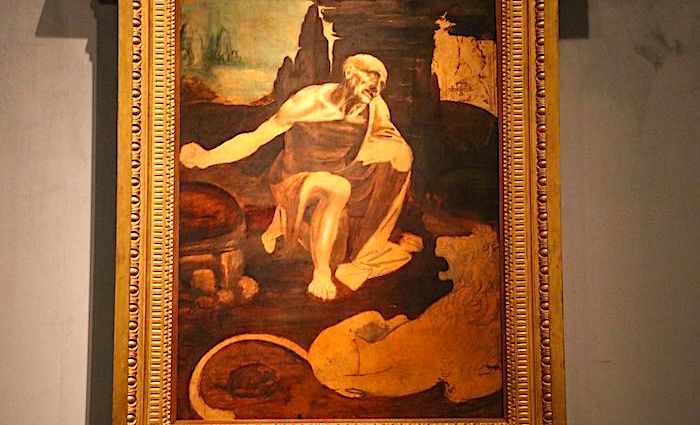
This is one of the most enigmatic paintings by the master, Da Vinci, and the story behind the art piece is even more intriguing. Da Vinci was known for not finishing many of his commissions since his brain seemed to outpace and outthink that of most mere mortals. While this art piece is only a sketch, it reveals the genius of the man.
It depicts St. Jerome who, for his love of God, lived as an ascetic for many years in the Syrian desert. He’s always depicted in an emaciated manner, and this sketch is no different. Old and bald in the picture, he has the look of a man who has endured serious pain in his life. He’s sitting down with the lion at his feet (his companion after having pulled a thorn from the lion’s foot). Also, he holds a rock in his hand, which he would traditionally use to beat himself on the chest as penance.
The first time we hear of this art piece is at the beginning of the 19th century on Angela Kauffman’s death. It was supposedly in her will but disappears from history until it is bought by Napoleon’s uncle, Cardinal Joseph Fesch.
The story is quite fascinating as it appears that it was divided into two pieces. The lower part was found in a second-hand shop where it was used as the cover for a box. The upper part, with St. Jerome’s head, was found at his shoe maker’s, where it was used as a cover for his stool. Upon his death, it was auctioned and exchanged hands a few times. It was finally bought by Pope Pius IX in 1856 where it has been ever since.
6. St. Matthew (Guido Reni)
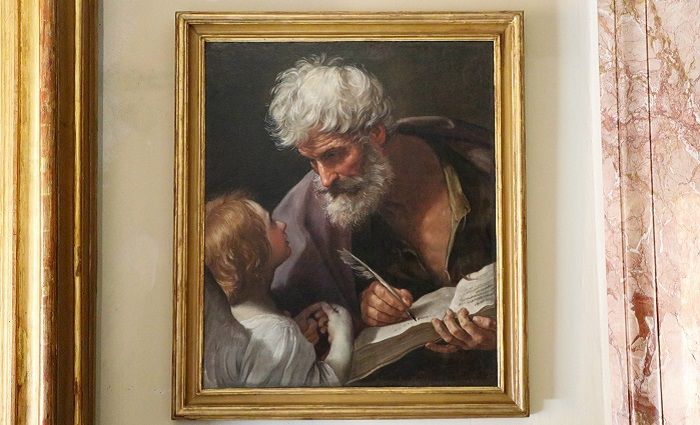
Guido Reni was part of the group of artists from Bologna who would burst onto the Italian painting scene in the 17th century and redefine the term “baroque”. Together with the Carracci cousins and Domenichino, they started the academy called Incamminati. This was a rebellion over the Manneristic paintings of the time. Creating a more classical movement, they redefined an entire generation of painting.
This piece shows the Apostle Matthew as he takes a break from his writing to look at an angel. Gone are the days of ideal beauty and deep perspective from the High Renaissance as we look at this masterpiece. As a result, the apostle has been depicted as an old man we would recognize today, with wrinkles on his forehead, disheveled hair, and straining veins in the neck. The angel has rosy cheeks and an almost anemic look that you could find in many boys today.
The magic of this painting is the action taking place. Neither of them is speaking. The angel looks up at St. Matthew in a loving manner who returns the look of affection with his own loving gaze. If this scene was taken out of context, you would easily think it was a painting of a grandfather and grandson, expressing their love for each other. It’s as if they don’t need to speak to understand each other perfectly.
5. Deposition (Caravaggio)
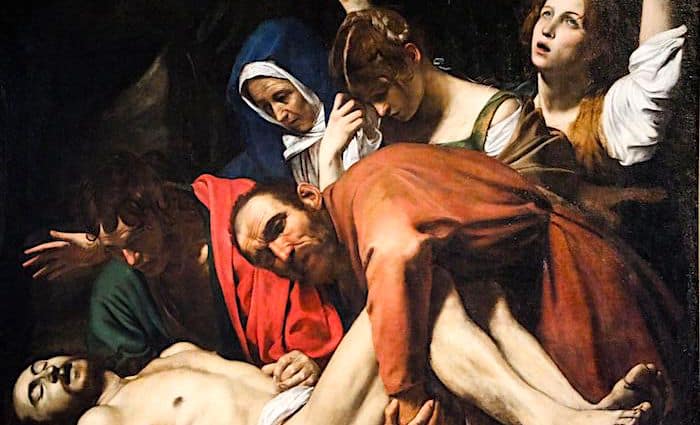
It would be difficult not to write an entire book about this painting or about Caravaggio’s artwork in general. His impact on painters and paintings in the 17th century with his realist trend is mind-boggling. Up to this point, there were set templates of how to paint saints and holy people. Caravaggio smashed these concepts, forever changing the art world.
Here, in one of Caravaggio’s greatest masterpieces, we see Jesus not being laid in the tomb but on the anointing stone by Nicodemus and John. Close to him are the Virgin Mary, Mary Magdalene, and Mary of Cleophas who is raising her arms and eyes towards heaven in prayer.
It’s an extremely pious moment with everyone’s expressions of sadness. There’s no perspective—only blackness. You can also see the muscles bulging from Nicodemus’ legs. There’s nothing ideal expressed here except the extreme agony that everyone present experiences.
Caravaggio’s life was anything but usual. Known to walk around Rome with a sword, he was supposedly part of a local gang and even killed a man in a duel. As a result, he was forced to flee Rome and made many travels south painting along the way from Naples to Sicily, Malta, and back. As the legend goes, he was waiting for a pardon from Pope Urban VIII when one of his enemies finally caught up with him and killed him in Porto Ercole.
Popular Vatican Tours
Best Selling Tour
Privileged Entrance Vatican Tour with Sistine Chapel
Without the right access, visiting the Vatican means fighting crowds, long waits, and missing the most significant rooms and works of art. Our privileged entrance tour offers more than just entry—it’s an immersive experience led by a storytelling guide who brings the Vatican to life. Skip the line and explore the Vatican Museums, including the Raphael Rooms and the Sistine Chapel, with engaging insights that make each moment memorable and meaningful.
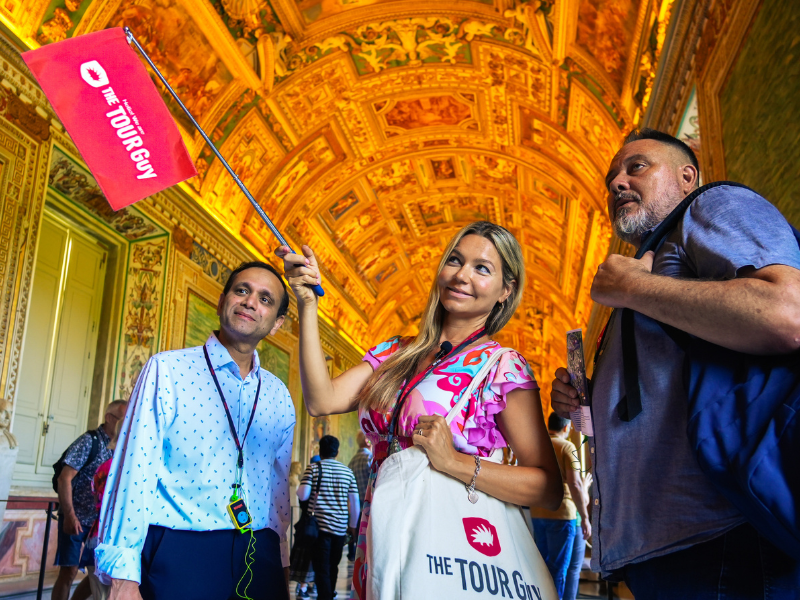
Exclusive Value
Vatican at Closing Time with Sistine Chapel
Exploring the Vatican during the day can mean massive crowds and enduring long lines. With skip-the-line access and an engaging guide, you’ll uncover the captivating stories behind the galleries and enjoy the awe-inspiring beauty of Michelangelo’s Sistine Chapel in a serene setting. Your friendly guide offers a rare perspective, allowing you to experience the Vatican Museums after most visitors have left, making your visit truly extraordinary.
See Prices
Not ready to book a tour? Check out our best Vatican tours to take and why.
4. Crucifixion of Saint Peter (Guido Reni)
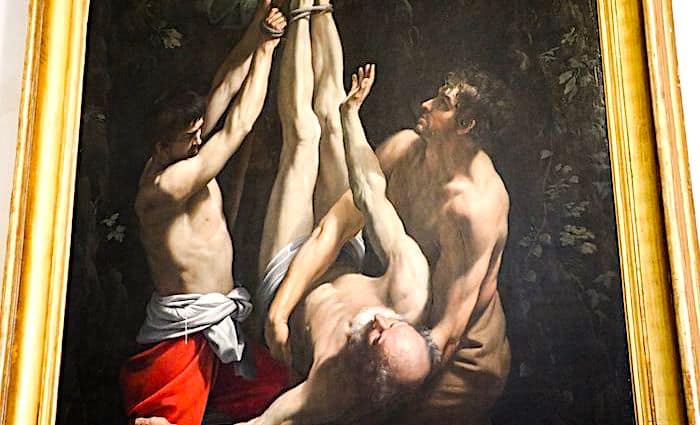
Caravaggio’s influence on Guido Reni in this painting is undeniable. This work, painted in 1605, marks Guido Reni’s first success in Rome. Cardinal Pietro Aldobrandini commissioned the painting for the S. Paolo alle Tre Fontane church. Later, it was sent to Paris, like so much other artwork. Eventually, Pius VII brought it back to Rome in 1819 where it has remained in the Pinacoteca ever since.
Guido Reni would have seen many of Caravaggio’s works in other churches in Rome, including a painting of the same subject by Caravaggio in the church Santa Maria del Popolo. The painting shows St. Peter being crucified for his Christian faith during the reign of Nero in A.D. 68. St. Peter didn’t feel worthy of the same death as Jesus and requested to be crucified upside down, depicted here.
The first thing you notice is the real-life muscle tone of St. Peter. You can see there’s nothing idealized here. This could have been a real representation of what his body looked like.
Next, you’ll notice that there’s no perspective, so nothing is happening in the background—there’s only blackness. This allows you to focus 100% of your attention on the scene taking place. Finally, you notice the faces of the two men who are crucifying him. There’s basically no expression on their faces—neither sorrow nor malice, it just is.
3. Martyrdom of St. Erasmus (Nicolas Poussin)
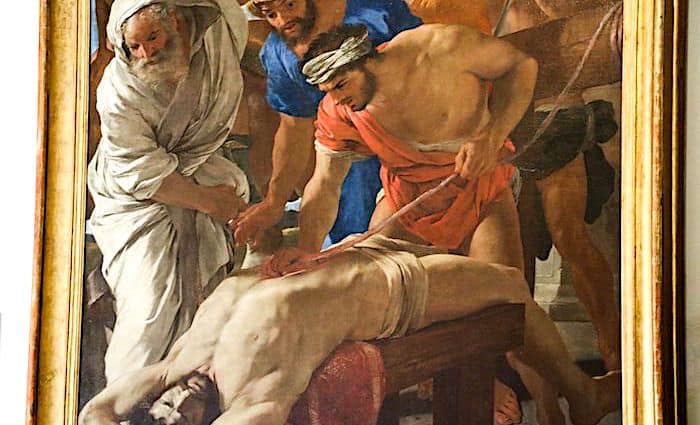
This dramatic painting is Nicolas Poussin’s first in Rome and intended for the altar in the right transept of St. Peter’s Basilica. The subject was chosen for the relics of the saint preserved there. Also taken to Paris and finally returned to Rome in 1820 by Pius VII, this painting found a home in the Pinacoteca where it remains to this day.
The painting depicts the martyrdom of St. Erasmus during the persecutions of Emperor Diocletian in A.D. 303. The future saint is stretched out with his hands behind his back. Meanwhile, the executioner pulls his intestines from his body and rolls them around a sailor’s capstan.
Above him, a pagan priest points to a statue of Hercules, which Erasmus refused to pray to. There are also angels coming down to him who offer him the palm and crown—both symbols of martyrdom.
Besides the graphic nature of the painting, Poussin used extremely vivid colors, especially white, blue, and red. At this point, we’re at the height of baroque and the realist movement started by Caravaggio.
Most people don’t know that the painter Pietro da Cortona was actually commissioned for this painting. It was then handed over to Poussin who even used the preparatory sketches made by da Cortona for the painting.
2. Astronomical Observations (Donato Creti)
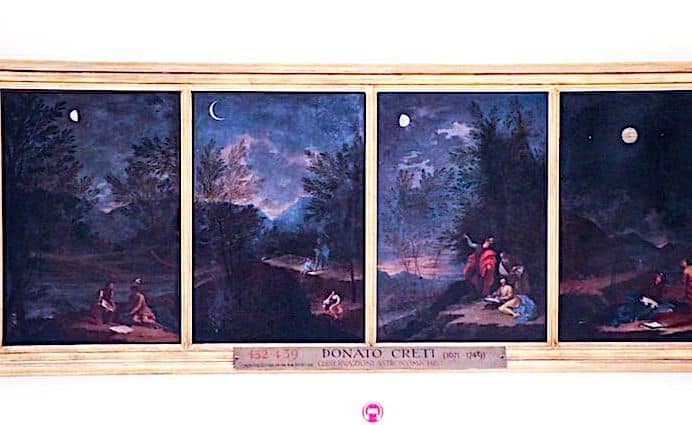
The Bolognese count Luigi Marsili commissioned this series of paintings to create a collection and gift them to pope Clement XI. The idea was to create a strong case for the church to understand the importance of an astronomical observatory. His plan worked as it was blessed by Pope Clement and an observatory was opened soon after in Bologna.
The collection is actually made up of eight canvases, which show the astronomical bodies known at the time: the Sun, Moon, Earth, Mars, Venus, Jupiter, Saturn, and a comet. The only one missing is Uranus, which wouldn’t be discovered until 1781.
In the painting, you’ll notice various telescopes and optical instruments used at the time to observe the celestial bodies. In the background, you’ll also see many figures of people observing these gigantic bodies in 18th-century clothing.
Looking at this painting allows you to travel back in time to the early 18th century and see what it would have been like to be an astronomer in those days. Imagine the excitement of looking into the night sky and seeing all of these heavenly bodies 250 years before the invention of the TV. Also, the power of their instruments is on display since we know that they could already see the rings around Saturn.
1. Adam and Eve in the Garden of Eden (Wenzel Peter)
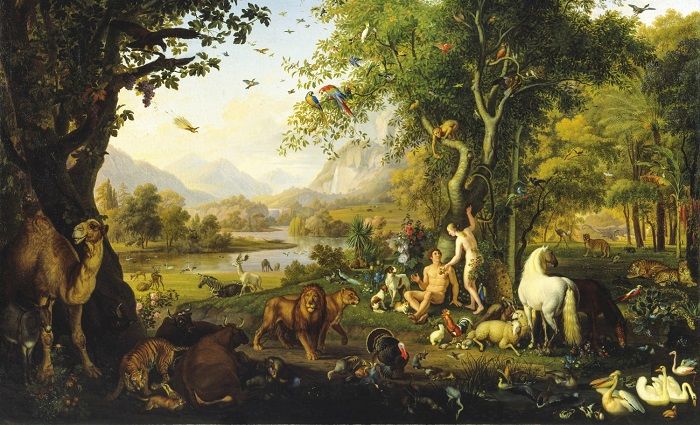
At first, the painting may strike you as a bit odd to have in the Vatican Collection. Upon further examination, you’ll see that this is one of the most devout paintings in the collection.
Wenzel Peter was an animalist painter, which means that he specialized in painting animals of all sorts. Due to his dedication to one particular type of painting, he was able to portray these animals in an extremely realistic way. Either sitting or standing, the figures look so true to form it could almost be a photograph.
The masterpiece portrays the Garden of Eden with Adam and Eve. They are both pleasantly portrayed here as two young people living in paradise. There’s nothing vulgar or too “realistic” about them and both of them are covered naturally so as not to show any indecency.
There are over 200 animals from all over the world in this painting and precisely portrayed. Since this is the Garden of Eden, you’ll notice that the animals, regardless of type, are all living in harmony together with humans. This is how it would have been in the beginning, according to Genesis.
Gregory XVI (pontiff from 1831 to 1846) liked his paintings so much that, in 1831, he purchased 20 pieces to put in the Room of the Consistory in the Papal State Apartment. You’ll notice that in the 18th century, artists started to reintroduce perspective by portraying long distances again. This comes after the 17th century when artists chose a black background over perspective and depicted figures “realistically”, which could even be crude.
Not ready to book a tour? Find out if a Vatican tour is worth it.
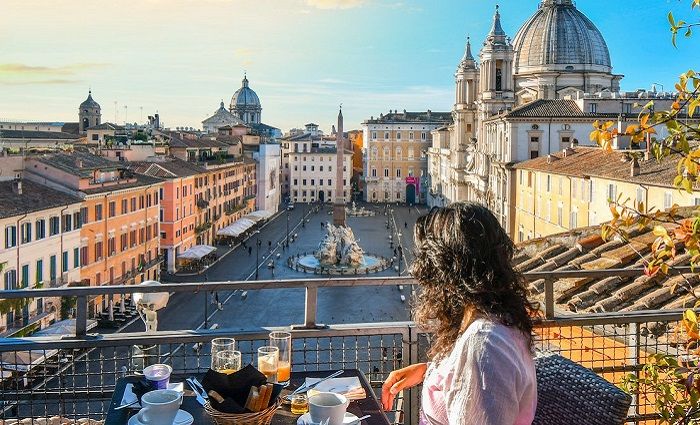
Where To Stay in Rome
Rome has a rich cultural history and many iconic landmarks to explore. Plan where to stay in the magnificent Eternal City in the best neighborhoods.

